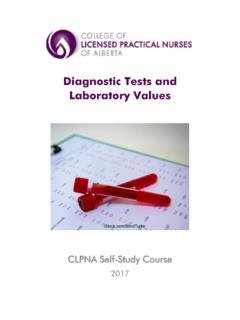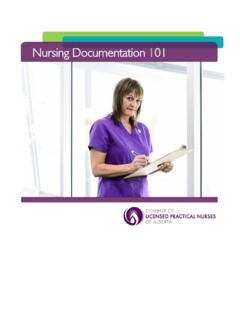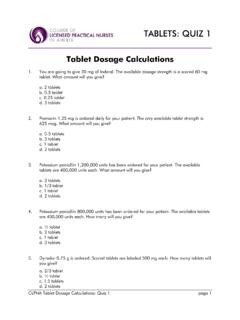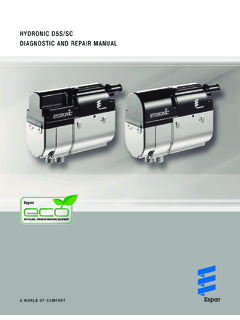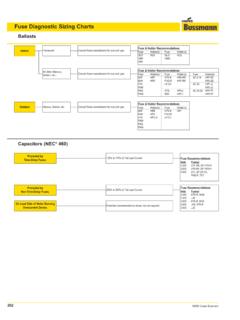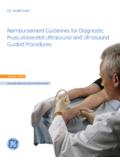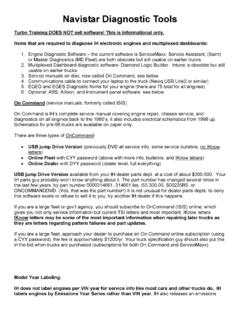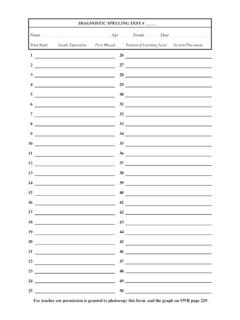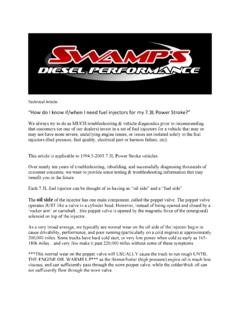Transcription of Diagnostic Tests and Laboratory Values - Study …
1 Diagnostic Tests and Laboratory Values CLPNA Self- Study Course 2017 CLPNA Diagnostic Tests & Laboratory Values P a g e | i Acknowledgements he development of this resource guide is an initiative of the College of Licensed Practical Nurses of Alberta (CLPNA). Production of this professional development initiative has been made possible through a grant from Alberta Labour, Foreign Qualification Recognition branch. Content and Review Dr. John Collins has attained broad experience in the fields of nursing and education. He has worked as an RN and an RPN in clinical practice, administration, research, and education. As an individual who has completed undergraduate, graduate, and postgraduate studies, John Values the principle of lifelong learning and encourages others to follow this path with a view to providing excellence in client care. Jason Richmond is an advanced-care paramedic with experience in health care, education, and curriculum development.
2 He is currently pursuing a master of education in distance education. Jason was the founding chairperson of the Continuing Education Centre for Emergency Services, which continues to provide free continuing education. Further, he is a strong advocate for integrated practice between health professions and open education. Editing of this module was done by Heather Buzila, who has broad editorial experience that includes educational materials and fiction and nonfiction manuscripts. Programming and Production The design and programming of this course was done by Russell Sawchuk of Steppingstones Partnership, Inc., and Learning Nurse Resources Network. Legal and Copyright This self- Study course is intended to support the continuing education of Alberta s Licensed Practical Nurses. This course is intended as a refresher and is not a substitute for proper accreditation or training. Always follo w you r employ er s prop er polici es and procedures.
3 College of Licensed Practical Nurses of Alberta, 2017 Published by the College of Licensed Practical Nurse of Alberta St. Albert Trail Place 13163 146 Street Edmonton, Alberta T5L 4S8 Tel: 780-484-8886 Website: Email: T CLPNA Diagnostic Tests & Laboratory Values P a g e | ii Diagnostic Tests and Laboratory Values Table of Contents Introduction to Diagnostic Tests and Laboratory Values ..1 Module 1: Diagnostic Procedures ..2 Introduction .. 2 Angiography .. 3 Arthroscopy .. 4 Bone scan .. 5 Bronchoscopy .. 6 Computed Tomography (CT Scan or CAT Scan) .. 7 Cystoscopy .. 8 Doppler studies .. 9 Echocardiography .. 10 Electrocardiogram (ECG, EKG) .. 11 Electroencephalogram (EEG) .. 12 Electromyography (EMG) .. 13 Endoscopy .. 14 Magnetic Resonance Imaging (MRI) .. 15 Myelography .. 16 Pulmonary Function Tests (PFT) .. 17 Radiography (X-Ray) Chest, Abdomen .. 18 Thallium Scan.
4 20 Tilt-table Test .. 21 Transesophageal Echocardiogram (TEE) .. 22 Ultrasound (Sonography) .. 23 24 Module 2: Application of Nursing Knowledge to Diagnostic Tests .. 25 Introduction .. 25 Scenarios .. 25 Case Studies .. 26 Answers .. 27 CLPNA Diagnostic Tests & Laboratory Values P a g e | iii Table of Contents Module 3. Overview of Laboratory Tests .. 31 Introduction .. 31 Common Lab Tests .. 32 CHEMISTRY Tests .. 33 Albumin (AL) .. 33 Ammonia (AMM, NH3) .. 34 Amylase (AMY) .. 35 Aspartate Transaminase (AST) .. 36 Blood Urea Nitrogen (BUN) .. 37 Chloride (Cl) .. 38 Creatine Kinase (CK) .. 39 Creatinine (Cr) .. 40 D-dimer (DDIMER) .. 41 Glucose (GLU) .. 42 Ischemia-Modified Albumin (IMA) .. 43 Lactate Dehydrogenase (LDH) .. 44 Potassium (K) .. 46 Sodium (Na) .. 47 Troponins (cTnT & cTnI) .. 48 Summary .. 48 HEMATOLOGY Tests .. 49 Complete Blood Count (CBC, Diff) .. 49 Components of Complete Blood Count (CBC).
5 49 Hemoglobin (Hgb) .. 51 Hematocrit or Packed Cell Volume (PCV) .. 51 Myoglobin (Mb) .. 52 Natriuretic Peptides: BNP/or NT-proBNT .. 53 Platelet Count (Thrombocytes) .. 54 White Blood Cell Count (WBC) .. 55 White Blood Cell Types (WBC Differential) .. 56 Summary .. 57 Coagulation Studies .. 58 Prothrombin Time (PT) .. 58 Partial Thromboplastin Time (PTT) .. 59 International Normalized Ratio (INR) .. 60 CLPNA Diagnostic Tests & Laboratory Values P a g e | iv Table of Contents Diabetes Studies .. 61 Fasting Plasma Glucose Test (FBS) .. 61 Oral Glucose Tolerance Test (OGTT) .. 61 Hemoglobin A1C (HbA1c) .. 62 URINE Tests .. 63 Urinalysis (UA) .. 63 Urine C & S (Culture & Sensitivity) .. 64 Urine Toxicology .. 65 Summary .. 65 Module 4. Nursing Implications and Applications of Lab Values .. 66 Introduction .. 66 Questions / Case Study .. 66 Self-Assessment .. 68 Summary .. 68 Endnotes.
6 69 Comments This resource is intended for Licensed Practical Nurses and adds to competency in nursing practice and the safety of clients. It is recommended that the LPN refer to CLPNA s Competency Profile for LPNs: for additional information regarding their scope of practice. Additional Comments The information found here is useful for the LPN s role as a caregiver and educator (explaining various lab Tests , the collection of specimens, and preparing clients for Diagnostic testing). Further reading or access to additional resources for training purposes is recommended. Some resources are posted at the end of this course. CLPNA Diagnostic Tests & Laboratory Values P a g e | 1 Introduction to Diagnostic Tests & Laboratory Values icensed Practical Nurses (LPNs) are responsible for providing safe, competent, and quality care to clients. It is an expectation of practice that they will critically appraise all assessment data to arrive at the best nursing care for each client.
7 This course provides information and learning activities related to Diagnostic Tests and Laboratory (lab) Values , one source of client assessment data. An LPN should understand the rationale for conducting specific Diagnostic and Laboratory Tests when delivering care, as well as the implications of the results of those Tests . The course lists common Diagnostic and lab Tests and Values in an organized manner, with opportunities for participants to test their knowledge through short case studies and interactive quizzes. Purpose According to Alberta s LPN Competency Profile, an entry-level LPN meets the knowledge requirement for obtaining, assessing, and monitoring Diagnostic Tests and lab Values commonly used in health This course is intended to review and extend an LPN s knowledge pertaining to Diagnostic Tests and lab Values so that safe and timely care may be delivered to clients. Course Outcomes On completion of this course participants will identify and describe commonly used Diagnostic procedures and lab Tests ; describe commonly ordered Diagnostic procedures and lab Values ; recognize principles of client teaching to the preparation and management of clients undergoingdiagnostic and lab testing; differentiate normal from abnormal results; and implement appropriate action as it relates to results to maintain a safe, competent, and ethical careto Outline This course consists of four modules: Module 1: Introduction to and overview of Diagnostic Tests .
8 This section gives the learner a brief overview of commonly ordered Diagnostic Tests used in a variety of settings where an LPN provides client care. Module 2: Nursing implications for Diagnostic Tests . This module encourages the learner to apply knowledge of Diagnostic Tests through responding to nursing case studies. Module 3: Overview of lab Values . The topics discussed in this section focus on Values limited to the most commonly ordered chemistry, hematology, and urine Tests . Module 4: Nursing implications for lab Tests . This section provides an opportunity to integrate information from Module 3 to check the LPN s competence through interactive online quizzes. L CLPNA Diagnostic Tests & Laboratory Values P a g e | 2 Module 1: Diagnostic Procedures Introduction iagnostic testing enables health care providers to diagnose, monitor, and treat conditions or anticipate changes in the health statuses of individuals.
9 LPNs are involved in both direct and indirect care of clients where Diagnostic procedures are anticipated (long-term care, maternity, pediatrics, community and public health, medical and surgical units in hospitals). Regardless of the nursing environment, client teaching is vital to encourage collaboration with procedures and facilitate obtaining the most accurate results. The LPN is proactive in assisting clients undergoing Diagnostic testing. The following Diagnostic Tests will be discussed in this module: Angiography Arthroscopy Bone scan Bronchoscopy Computed tomography (CT scan or CAT scan) Cystoscopy Doppler studies Echocardiography Electrocardiogram (ECG, EKG) Electroencephalogram (EEG) Electromyography (EMG) Endoscopy Magnetic resonance imaging (MRI) Myelography Pulmonary function Tests (PFT) Radiography (X-ray) chest, abdomen Thallium scan Tilt-table test Transesophageal echocardiogram (TEE) Ultrasound (Sonography) Module Outcomes Upon completion of this module, the participant will be able to list commonly used Diagnostic Tests ; identify the indications for various Diagnostic Tests ; explain the procedure(s) for various Diagnostic Tests ; recognize interfering factors in Diagnostic testing; and state the nursing implications of Diagnostic Tests .
10 Nice to This module uses some terminology that you should familiarize yourself with. For example, normal findings refer to Diagnostic results that are within expected or typical ranges. Indications refer to the reasons for obtaining Diagnostic studies ( , establish a diagnosis, monitor therapy, screen for disease). Procedure relates to the preparation of the client before the test and care of the client during and after the test. Interfering factors refers to those factors that could influence or alter test results ( , medications). Nursing implications refer to those aspects of care that are within the role of the LPN, including the need for client teaching. D CLPNA Diagnostic Tests & Laboratory Values P a g e | 3 Angiography Description2 n X-ray test that uses a special dye and camera (fluoroscopy) to take pictures of the blood flow in an artery ( , aorta) or a vein ( , vena cava). Common angiograms can look at arteries close to the heart, lungs, brain, head or neck, legs or arms, and the Indications To find the cause of chest pain or pressure ( , from myocardial infarction, angina, or pericarditis).
